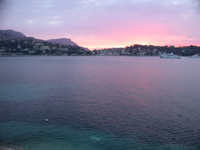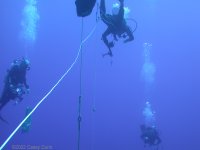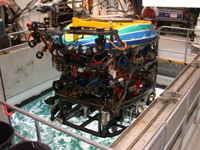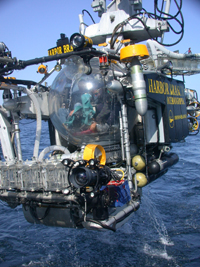
Sunrise from the Zoology Station in Villefranche sur mer.

Blue water divers off the east coast of the US. Each diver is tethered to the weighted downline.

Tiburon, a research ROV at the Monterey Bay Aquarium Research Institute. It is
capable of diving to 4000 meters.

Sea Link II, a manned submersible at the Harbor Branch Oceanographic Institute. It can dive to 1000 meters.
There are a few exceptional locations in the world where the right combination of wind, currents, and geography carry deep water animals that are usually found only in the open ocean, including siphonophores, right up to the surface waters along the coast. The most important of these locations is the bay at Villefranche-Sur-Mer, France, where a diversity of siphonophores can be collected each Spring. They can simply be scooped from the surface with buckets and brought back to the laboratories at the Zoological Station. Much of what we know about siphonophore biology is based on work done at this site, most of it in the 19th century.
Usually it is more difficult to get these animals, and we must go to them rather than wait for them to come to us. In the past this has meant trawling for them with nets from research ships at sea. This is not a delicate procedure, and it reduces most siphonophores to a nondescript goo. Now is an exciting time to work with these animals because the technology for sampling fragile organisms from the open ocean has vastly improved in recent years. With advances in diving protocols and submarine tools we can enter their environment ourselves, identify the animals we want, and gently pluck them from the water.
Blue water diving, a specialized type of SCUBA diving that involves a buoy and weighted tethers, allows divers to safely and routinely sample animals by hand in the upper 50 meters of the ocean even where it is thousands of meters deep. Special precautions are needed because there is no bottom close enough to save a diver from an uncontrolled descent to dangerous depths, and it would likely be lethal to drift far from the research ship.
Blue water diving is a spectacular experience. It is quite different from SCUBA diving near the shore, where your attention is usually drawn to the features of the bottom. The sensation experienced while blue water diving is much more like flying; there is no bottom, there is blue in every direction. No fixed points to orient to or to hold your eye. If it is a clear day and there is good visibility the swells above look like silvery ripples, and the light blue water to your sides fades to the navy blue of the depths. At night nothing can be seen but the beams of the dive lights and the animals that come into their luminous cones. When the lights are off each diver is surrounded by a cloud of bioluminescent particles, and even the wave of a hand makes the water startlingly bright. The ocean feels much smaller on these night dives, almost as if nothing exists except what you see with your light. Sometimes you will only see a few animals on the whole dive, and at other times (especially during vertical migration events) you are surround by so many thousands of gelatinous organisms that it feels more like diving in soup than the open ocean. When you see an animal you want you grab a jar from your bag and either get it to swim in or use a flicking motion of the lid to create a current that carries it inside.
The collecting capabilities of research submersibles have improved dramatically at the same time that blue water diving protocols have been ironed out. Specialized samplers with hydraulically actuated lids can be remotely opened, slipped up around an animal, and then closed. Animals can also be sucked up using a glorified vacuum cleaner that puts each specimen in its on collection vessel. Submersibles with collection capabilities come in two types: manned submarines and remotely operated vehicles (ROVs). Manned submarines are untethered and can carry several people, ROVs are connected to the mothership with a wire and are controlled from above.

